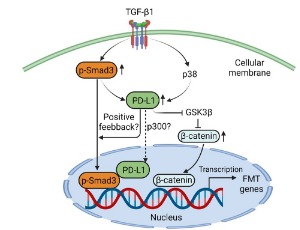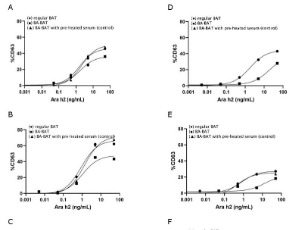Loading
Journal of Cellular Immunology
ISSN: 2689-2812

2022
Volume 4, Issue 4, p121-157
Articles published in this issue are Open Access and licensed under Creative Commons Attribution License (CC BY NC) where the readers can reuse, download, distribute the article in whole or part by mentioning proper credits to the authors.
PD-L1 as a Novel Mediator of Lung Fibroblast to Myofibroblast Transition
Xia Guo, Guoqing Qian
Idiopathic pulmonary fibrosis (IPF) is an incurable disease that affects approximately 3 million people worldwide. Although two drugs (nintedanib and pirfenidone) have been approved for treatment of IPF, currently there is a lack of effective pharmacotherapy that could stop the progression or offer a cure for this devasting disease.
J Cell Immunol, 2022, Volume 4, Issue 4, p141-144 | DOI: 10.33696/immunology.4.142
Persistence, Pathogenicity and Plasticity: The Role of IL-23 in Th17 Fate
Jens C. Kleiner, Christian F. Krebs
Focusing on adaptive immunity there is a humoral and a cellular immune response. The humoral response is executed by antibodies acting via antigen specific binding. These antibodies are produced by activated B-lymphocytes in order to bind and neutralize antigens.
J Cell Immunol, 2022, Volume 4, Issue 4, p121-130 | DOI: 10.33696/immunology.4.140
CAR Therapy for T-cell Malignancies
Andrew Cinquina, Jia Feng, Hongyu Zhang, Yupo Ma
The introduction of chimeric antigen receptor (CAR) immunotherapy has been revolutionary in the treatment of hematological malignancies.
J Cell Immunol, 2022, Volume 4, Issue 4, p131-133 | DOI: 10.33696/immunology.4.141
Improvement of the Specificity of the Indirect BAT for the Diagnosis of Peanut Allergy; the BA(Blocking Antibodies)-BAT
Janneke Ruinemans-Koerts, Monique van Uum-Otters, Don van Baar, Joost van Neerven, Judit Wesseling
The direct and indirect Basophil Activation Test (BAT) are well known for their capacity to predict the presence of an IgEmediated peanut allergy resulting in a reduction of expensive and time-consuming oral food challenge (OFC) tests. Although the BAT is a promising test, false-positive and false-negative outcomes are observed .
J Cell Immunol, 2022, Volume 4, Issue 4, p145-148 | DOI: 10.33696/immunology.4.143
Manufacturing of Human T-lymphoid Progenitors from Two Different Hematopoietic Stem Cell Sources and Perspective for New Immunotherapies
Pierre Gaudeaux, Ranjita Devi Moirangthem, Pauline Rault, Hanem Sadek, Francesco Carbone, Marieke Lavaert, Akshay Joshi, Tom Taghon, Isabelle André, Olivier Nègre, Tayebeh-Shabi Soheili
Adaptive immunity relies on an efficient lymphocyte response, enabling an organism to defend itself against infections or malignancies. Lymphocyte repertoire may be impacted by various factors, including conditions such as primary immune deficiencies or Acquired Immunodeficiency Syndrome (AIDS), or by treatments such as chemotherapy.
J Cell Immunol, 2022, Volume 4, Issue 4, p149-157 | DOI: 10.33696/immunology.4.144
Recommended Articles
Chimeric Antigen Receptor CAR NK Cells Emerging Immunotherapy for the Treatment of Cancer
Although NK cells are recognized as effector lymphocytes of the innate immune system, they also regulate the adaptive immune response by releasing inflammatory cytokines and developing immunological memory. Unlike other lymphocytes such as T or B cells, NK cells do not express rearrangeable, antigen-specific receptors.
Uniportal VATS Lobectomy for Lung Cancer: Feasibility and Cost Effectiveness in a Single Center Experience
In last decades, video-assisted thoracic surgery (VATS) together with robotic-assisted thoracic surgery (RATS) can be considered the biggest innovation in thoracic surgery. This approach drastically changed the way of performing surgical operations, improving patient’s outcome undergoing thoracic surgery.
Identification of the Molecular Basis of Anti-fibrotic Effects of Soluble Guanylate Cyclase Activator Using the Human Lung Fibroblast
Idiopathic pulmonary fibrosis (IPF) is an irreversible fibrotic lung disease with unknown etiology [1-3]. Although two approved medications, pirfenidone and nintedanib, are able to slow down lung function decline in IPF patients, many other chronic pathologic conditions such as dyspnea and pulmonary hypertension (PH) and overall disease progression,
Deubiquitinase as Potential Targets for Cancer Immunotherapy
During the last few decades, immunotherapy is considered to be an important approach to help our immune system to fight various kinds of diseases, such as tumor. Sometimes, it works very well for some types of cancers, for example: bladder cancer, colorectal cancer, breast cancer and lymphoma.
Early Onset Fetal Growth Restriction: Does Path to Diagnosis Impact Outcomes and Pathology?
The etiology of fetal growth restriction is rooted in inadequate maternal-placental vascular malperfusion (MVM) of the placenta. Risk factors for MVM are broad and include maternal, fetal, and placental antecedent determinants.
Role of the Gut Microbiome in the Modulation of Cancer Immunotherapy Response
The gut microbiome or gut flora is a vast community of microorganisms such as bacteria, viruses, protozoa, and fungi that inhabit the digestive tract of the human and other animals [1,2]. In the human body, bacterial species colonize into the oral cavity, skin, vagina, and placenta, however, the largest population of microorganisms resides in the intestine.
Commentary on “Integrative Transcriptomics, Proteomics, and Metabolomics Data Analysis Exploring the Injury Mechanism of Ricin on Human Lung Epithelial Cells”
Ricin toxin (RT) is classified as a potential bio-threat agent in assassinations and terrorism due to its extreme toxicity. Due to aerosol RT exposure is the most lethal route, it is urgent to study its injury mechanism.
Machine Learning for Healthcare: Emerging Challenges and Opportunities in Disease Diagnosis
Diagnosis is a process that identifies, explains, or establishes the individual’s disease from its symptoms and signs. Early and precise diagnosis is crucial since it influences the efficacy of treatment and avoids longterm complications for the infected person. Further, in the case of infectious diseases, undiagnosed patients can transmit the disease to a healthy population unknowingly. Besides, most of the diseases evolve with the time that significantly affects the clinical outcomes.
Surgery Versus Radiation Therapy for Early-Stage Lung Cancer: Patient Selection is Crucial
Lung cancer remains the leading cause of cancer related death in the United States with mortality rates surpassing breast, prostate, brain, and colorectal cancers combined. Recent data shows that susceptibility for both men and women for developing invasive lung and bronchogenic carcinoma peak after the age of 70 years.
Multidirectional Benefits of Nanotechnology in the Diagnosis, Treatment and Prevention of Tuberculosis
Despite the curious advancement in medical science and therapeutics, tuberculosis (TB) persist the primary factor of mortality than any other infectious disease and socioeconomic disaster for millions of people around the world. According to the World Health Organization (WHO), World’s One-third of the population is infected with this disease and of these, 8 to 10 million people develop active disease and 2 million people die each year and the rest of the infected people remain asymptomatic.
Cardiac Stem Cell Therapy, Quo Vadis
Cardiovascular disease causes 30% of global mortality and is still the number one cause of death worldwide. A main patho-physiological process is the coronary disease leading to malperfusion and ischemic cardiac disease as well as cardiac infarction.
CTLA-4 and PD-L1 or PD-1 Pathways: Immune Checkpoint Inhibitors and Cancer Immunotherapy
The immune system developed certain checks and balance to control or inhibit the reactivity against normal cells of the body. Uncontrolled immune responses to the non-self entities such as bacteria, viruses, parasites, or mutated self-antigens can cause an inflammatory reaction and autoimmune diseases.
Cancer Nanomedicine: Strategies to Enhance Tumor Delivery and Immunotherapy
Cancer nanomedicine was originally developed for more efficient delivery of chemotherapeutic agents into tumor, and has been extensively employed as a therapeutic for cancer treatment owing to its unique features in drug delivery, diagnosis and imaging, as well as the therapeutic nature of some nanomaterials themselves.
Targeting "Do Not Eat Me" Signal CD47 in Cancer Immunotherapy
Cells of the innate and adaptive arm of the immune system including macrophages, natural killer (NK) cells, neutrophils, T cells, and B cells, etc. are crucial for the maintenance of the body’s homeostatic balance and prevention of multiple diseases including cancer.
Bronchoscopic Lung Volume Reduction Operation and Pulmonary Rehabilitation
The main symptom in Chronic Obstructive Pulmonary Disease (COPD) is shortness of breath. Shortness of breath occurs especially with exercise and progresses over the years despite all medical treatments. One of the main mechanisms by which this symptom occurs is hyperinflation in the lungs [1].
The Clinical Utility of Outpatient Continuous Glucose Monitoring in Establishing Insulinoma Diagnosis in a Patient with Impaired Nocturnal Hypoglycemia Awareness
Insulinomas are insulin secreting tumors arising from spontaneous mutations of the ductal, acinar, or islet cells of the pancreas. They are rare, having an incidence of only four cases per million people per year. Patients typically present with fasting hypoglycemia, experiencing neurologic symptoms like confusion, changes in vision, or abnormal behavior and autonomic symptoms like palpitations, diaphoresis, or tremulousness.
Progress in Diagnosis and Treatment of Immune Checkpoint Inhibitor-Associated Cardiotoxicity
Immune checkpoint inhibitors (ICIs) are a new type of broad-spectrum antitumor drugs, which mainly include cytotoxic T-lymphocyte-associated protein-4 (CTLA-4) inhibitors, programmed cell death protein-1 (PD-1) and its ligand PD-L1 inhibitors. Since 2011, ICIs have been approved for more than 20 kinds of malignant tumors.
Prevention of Lung Cancer Growth by Water Extract from Euglena gracilis
As a source of novel drugs and dietary supplements, natural products from plants and animals have been studied for more than decades. Unicellular algae, such as Chlorella, Spirulina and Euglena, are such resources. Euglena gracilis is a unicellular green alga found in fresh water.
Multiple Roles of the Interleukin IL-17 Members in Breast Cancer and Beyond
Worldwide, breast cancer is the most-common invasive cancer in women. Commonly used treatments include surgery, hormonal therapy, radiotherapy, chemotherapy and targeted therapy. Failure of these treatments is often due to intrinsic or acquired resistances and is responsible for most relapses of cancer [1]. Heterogeneity among patients and tumors, together with the versatility of cancer make drug resistance more challenging to deal with.
ProLung™-budesonide Inhibits SARS-CoV-2 Replication and Reduces Lung Inflammation
Inhaled budesonide benefits patients with COVID-19. ProLung™-budesonide enables the sustained, low dose administration of budesonide within a delivery vehicle similar to lung surfactant.
About Scientific Archives
Scientific Archives is a global publisher initiated with the mission of ensuring equal opportunity for accessing science to research community all over the world. Spreading research findings with great relevance to all channels without any barrier is our goal. We want to overcome the challenges of Open Access with ensured quality and transparency.
